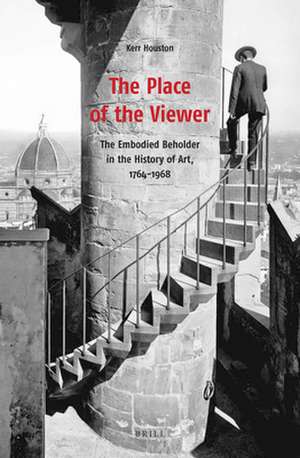The Place of the Viewer: The Embodied Beholder in the History of Art, 1764-1968
Autor Kerr Houstonen Limba Engleză Hardback – 19 iun 2019
Preț: 619.49 lei
Preț vechi: 755.48 lei
-18% Nou
Puncte Express: 929
Preț estimativ în valută:
118.54€ • 124.10$ • 98.08£
118.54€ • 124.10$ • 98.08£
Carte indisponibilă temporar
Doresc să fiu notificat când acest titlu va fi disponibil:
Se trimite...
Preluare comenzi: 021 569.72.76
Specificații
ISBN-13: 9789004400238
ISBN-10: 9004400230
Dimensiuni: 155 x 235 mm
Greutate: 0.7 kg
Editura: Brill
Colecția Brill
ISBN-10: 9004400230
Dimensiuni: 155 x 235 mm
Greutate: 0.7 kg
Editura: Brill
Colecția Brill
Cuprins
Acknowledgements
List of Figures
Introduction
1 “A Hundred Different Points of View:” Baudelaire and the Place of the Viewer
2 A Brief Prehistory of Interest in the Physical Viewer
3 The Place of the Viewer: Perspectives and Approaches
1 The Communicative Viewpoint: Photography, Frontality and Multiplicity in the 1800s
1 Art History, Distance, and the Photograph
2 “When a Choice Has Been Made”: Talbot, Ruskin, and the Place of the Photographer
3 Photography as Language: Subjective and Objective Viewpoints in the 1850s
4 Constructed Viewpoints: Art History, Photography and Related Discourses, 1860–1880
5 Remote Viewing: Connoisseurship and Photography in the Late 1800s
6 The Appeal of die reine Frontansicht: German-language Scholarship in the 1890s
7 The Center Cannot Hold: Multiple Viewpoints in the Early 1900s
8 Conclusion
2 The Beholder in Motion: Kinetic Viewership
1 Introduction: Recent Assertions about Kinetic Viewership
2 Landskips and Kinema: towards a Prehistory of the Kinetic Viewer
3 Freud and Moses, Empathy and Kinesis
4 Space, Time, and the Work of Art in the 1920s and 1930s
5 Motion and Nomenclature: the Arrival of the Kinetic Viewer
6 Conclusion
3 The Body Physical, the Body Politic: Incorporated Viewership in the 1960s
1 Sides at War: Viewership and the Viewer in the 1960s
2 The Active Viewer: Politics and Artistic Discourses, c. 1960
3 Embodied Poses: Leo Steinberg and Kinesthetic Empathy
4 Ideas in Translation: Gestalt Theory and Phenomenology
5 The Place of the Viewer in ‘Art and Objecthood’
6 Conclusion
Epilogue: Art History and the Place of the Viewer since 1968
1 The “Idea of the Spectator”: Theorizations of the Audience, c. 1972
2 The Persistent Centrality of the Viewer
Bibliography
Index
List of Figures
Introduction
1 “A Hundred Different Points of View:” Baudelaire and the Place of the Viewer
2 A Brief Prehistory of Interest in the Physical Viewer
3 The Place of the Viewer: Perspectives and Approaches
1 The Communicative Viewpoint: Photography, Frontality and Multiplicity in the 1800s
1 Art History, Distance, and the Photograph
2 “When a Choice Has Been Made”: Talbot, Ruskin, and the Place of the Photographer
3 Photography as Language: Subjective and Objective Viewpoints in the 1850s
4 Constructed Viewpoints: Art History, Photography and Related Discourses, 1860–1880
5 Remote Viewing: Connoisseurship and Photography in the Late 1800s
6 The Appeal of die reine Frontansicht: German-language Scholarship in the 1890s
7 The Center Cannot Hold: Multiple Viewpoints in the Early 1900s
8 Conclusion
2 The Beholder in Motion: Kinetic Viewership
1 Introduction: Recent Assertions about Kinetic Viewership
2 Landskips and Kinema: towards a Prehistory of the Kinetic Viewer
3 Freud and Moses, Empathy and Kinesis
4 Space, Time, and the Work of Art in the 1920s and 1930s
5 Motion and Nomenclature: the Arrival of the Kinetic Viewer
6 Conclusion
3 The Body Physical, the Body Politic: Incorporated Viewership in the 1960s
1 Sides at War: Viewership and the Viewer in the 1960s
2 The Active Viewer: Politics and Artistic Discourses, c. 1960
3 Embodied Poses: Leo Steinberg and Kinesthetic Empathy
4 Ideas in Translation: Gestalt Theory and Phenomenology
5 The Place of the Viewer in ‘Art and Objecthood’
6 Conclusion
Epilogue: Art History and the Place of the Viewer since 1968
1 The “Idea of the Spectator”: Theorizations of the Audience, c. 1972
2 The Persistent Centrality of the Viewer
Bibliography
Index
Notă biografică
Kerr Houston (Ph.D., Yale, 2001) has taught art history and criticism at The Maryland Institute College of Art since 2002. He is the author of An Introduction to Art Criticism (2013), and numerous articles and reviews.
